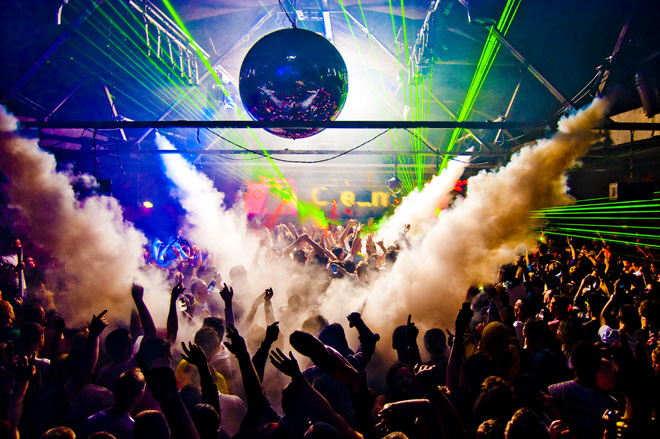When you’ve liked electronic music for a number of years, there comes a certain shame in listening to a mainstream dance music track. Admitting you think a certain Avicii song isn’t bad (or has a catchy melody) comes with that voice in the back of your head going, “But that’s not real dance music. He didn’t use a drum machine, or tool around with an Emulator. He’s not even a real DJ. Commercialism!”
And while from a musical perspective, Avicii’s put out a few decent tracks since his rise to fame (although his DJing is hit or miss), reaching that level on the Beatport and now Billboard charts comes with all the baggage associated with listening to a Britney Spears song: “Is okay to actually be liking this, or am I not a real electronic music fan?”
But if you’ve listened to electronic music for at least a decade or more, you know that between-the-genre disagreements aren’t anything new. Back in the early aughts, flame wars could be started on a New Order message board if a poster said he or she liked Depeche Mode, the Pet Shop Boys, Soft Cell, or any synthpop contemporary along those lines: New Order was for tough footballers who got into riots at shows, while the similar synth sounds of Depeche Mode or the Pet Shop Boys were for leather-wearing sissies.
But once you step back away from a performer’s appearance and fans’ snobbery (or in the case of some New Order fans, the tough-guy posturing that comes with admitting you go on the dance floor when “Blue Monday” gets cued up but reviles at “West End Girls”), the music is all there is. And the fact remains that, when you strip down plenty of ‘80s and ‘90s synthpop tracks, they can be distilled down into the same elements of sequencers, bass, and synth lines, and vocals. Different lyrics and vocal qualities, perhaps, and maybe New Order’s more badass for actually having a bass player and live drummer, but the style and composition really don’t vary between artists of the time and even carry over into other contemporary electronic genres like house, freestyle, and even – at a very distant observation – Eurodance.
Still, as much as old school ravers preach the PLUR, the peace, love, and unity components only seem to matter within a specific scene or subgenre. You’ve got the underground scoffing at the mainstream, instrumental electronic performers distancing themselves from the DJs, older artists rolling their eyes at the newcomers, and European DJs pointing out everything that’s wrong with EDM in North America.
On one hand, though, you can’t help but take one side. Underground and older performers tended to be more experimental, while Europe’s scene tends to see each subgenre, from house to hardstyle, as separate entities, rather than a single, collective sound. On the other, the attitude of “You suck, we’re better than you” pervades from the DJs through the fans and ultimately makes electronic dance music its own worst enemy.
So, what can be done?
1. It Starts With the Artists
Although bands and artists have talked smack about others in interviews for decades, Twitter creates more divisions.
For instance, DJ Sneak went on about Swedish House Mafia earlier last year, writing: “It’s a sad thing when the Swedish House Mafia is being paid big money to come to the US to play house music. For the record, they do not play house music.”
Steve Angello saw the statement and then replied: “If you’re trying to tell me something, call me. You have my number. Don’t take on Twitter to get a stab. It’s stupid of you calling people out like that on Twitter. We always respected you but you show a side that’s f–ked up.”
Although the quality of Swedish House Mafia can be debated, the house elements in some form remain – it might not be an evolution everyone agrees with, but saying their music isn’t “house” makes Sneak (any, really, any older performer writing this type of statement) seem dated. It’s like saying that only the Beatles or Elvis is “rock” and everyone after isn’t; Swedish House Mafia might be the Nickelback of EDM, but even older performers can still admit the “Photograph” band still falls within the vast scope of rock music.
At the same time, if you’re an older artist who scoffs at the success of younger performers, taking to Twitter is passive. Want to make a difference? When you’ve got a sizeable platform, even if it’s not the biggest, show just how great house music’s (or techno’s or dubstep’s) scope can be. Carl Cox, in an interview with the Wall Street Journal looks to have the right idea. “I’m not Carl Cox the hit player,” he explained in regards to his innovative track selection at shows that continue to draw large crowds. “I find I have to work hard for it. I have no idea what I’m going to play when I start.”

2. Understand the U.S. is Behind – and That’s Not Always a Bad Thing
Cyclical arguments about the origins and development of EDM perpetuate between critics and long-time fans. Although house and techno started on this side of the pond, they claim, Europe took it and improved it, and then the North Americans reclaimed it, only to bastardize it into a progressive house-brostep mishmash and attempt to export it back again.
In one sense, Europe’s longer history means greater subgenre distinctions have been drawn in mainstream and underground scenes. The U.S.’s mainstream, overall dismissive attitude toward any type of dance music for years meant a greater range and accepted diversity of sounds never had a chance to develop. “The US emphasis seems to have been about making dance music a commercial entity,” Cox told Beatport. “They deal success in numbers, big festivals, and strong branding, but they sometimes miss the element of quality. The American market is reduced to this umbrella term of ‘EDM,’ whereas Europe has this huge name for underground quality and so much of it. Most importantly, people still want to hear it.”
But while Cox is on the money about the current mainstream scene in North America (and also “mainstream,” vs. “underground”), Fedde Le Grand – considered by some to be a straddler of underground and mainstream dance music with his tracks less vocal-centric and actual DJing history – observed that it’s not an issue of Europe vs. North America, but rather the U.S. getting caught up.
“We had the same thing in Europe in the ’90s,” he told the Las Vegas Review Journal last year. “There was so much crap, basically.”
To a certain extent, Le Grand’s on the mark. What Europe vs. North American arguments tend to evade is the widespread popularity of Eurodance from the late ‘80s through the early ‘00s that eventually morphed into vocal trance – a more respectable genre in hindsight. Now that pop songs are getting the EDM treatment and house producers are collaborating with pop and hip-hop stars, the U.S.’s mainstream dance music scene is going through its own Eurodance period of sorts – overly commercial and formulaic, with house and trance elements blending together.
But as end of the year pieces for 2013 pointed out, this may change for 2014. The pop house pushed by David Guetta and Calvin Harris over the past couple of years is seeing other electronic elements follow close by: The revisited disco of Daft Punk and the glitchy garage of Disclosure being two of the most prominent and, frankly, different.
3. Like It? No. Accept It? Maybe.
Rather than hate on certain artists for getting higher chart ranks or having more prominent festival placement, or ridicule North America’s EDM for being a decade behind Europe, what fans and artists need is a resolution.
Speaking about the underground vs. mainstream discord, Luke Solomon of record label Classic said in 2012 that both scenes need to acknowledge they feed off each other and, until recently, remained out of the media together. “One would never exist without the other, and, they feed each other with ideas, anger, exasperation, enlightenment, and revolution,” he said, “it wasn’t that long ago that dance music couldn’t get arrested. Guitar bands were at the forefront of popularity and the industry thrived off the rise of bands like the Libertines and the Arctic Monkeys.”
And much like New Order fans claiming the group behind “True Faith” can’t be put in the same category as Depeche Mode and other synthpop artists, Richard B. Scott II wrote for Festival Advisor that, even if older fans don’t like the newer sounds, that’s no excuse to invalidate and dismiss the latest group of performers. “So what if the neon kids and the black clad underground kids don’t see eye to eye on the music?” he wrote. “That’s the beauty of diversity. EDM isn’t geared towards a terribly discerning audience just like underground music isn’t meant for mass appeal.”
So where do you stand in the EDM wars?




